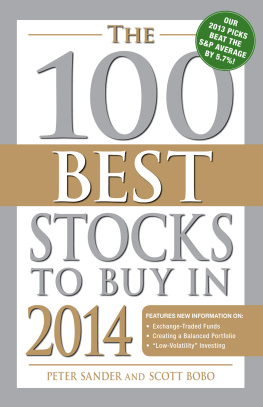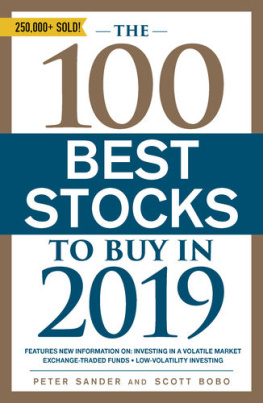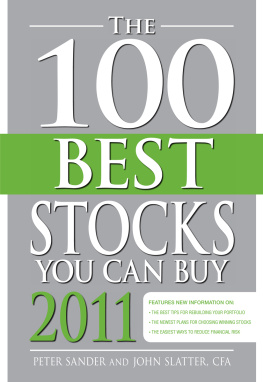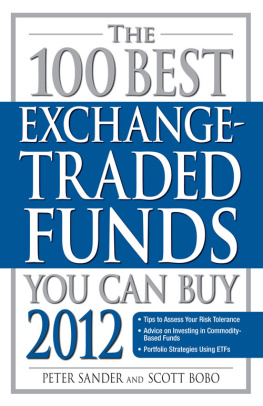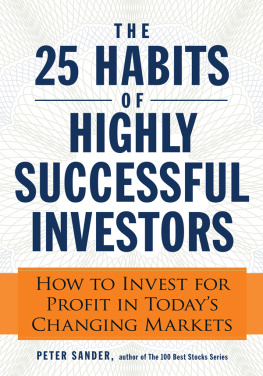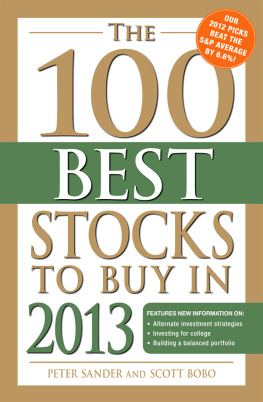Peter Sander - The 100 Best Stocks to Buy in 2019
Here you can read online Peter Sander - The 100 Best Stocks to Buy in 2019 full text of the book (entire story) in english for free. Download pdf and epub, get meaning, cover and reviews about this ebook. publisher: Adams Media, genre: Business. Description of the work, (preface) as well as reviews are available. Best literature library LitArk.com created for fans of good reading and offers a wide selection of genres:
Romance novel
Science fiction
Adventure
Detective
Science
History
Home and family
Prose
Art
Politics
Computer
Non-fiction
Religion
Business
Children
Humor
Choose a favorite category and find really read worthwhile books. Enjoy immersion in the world of imagination, feel the emotions of the characters or learn something new for yourself, make an fascinating discovery.

- Book:The 100 Best Stocks to Buy in 2019
- Author:
- Publisher:Adams Media
- Genre:
- Rating:4 / 5
- Favourites:Add to favourites
- Your mark:
- 80
- 1
- 2
- 3
- 4
- 5
The 100 Best Stocks to Buy in 2019: summary, description and annotation
We offer to read an annotation, description, summary or preface (depends on what the author of the book "The 100 Best Stocks to Buy in 2019" wrote himself). If you haven't found the necessary information about the book — write in the comments, we will try to find it.
The 100 Best Stocks to Buy in 2019 — read online for free the complete book (whole text) full work
Below is the text of the book, divided by pages. System saving the place of the last page read, allows you to conveniently read the book "The 100 Best Stocks to Buy in 2019" online for free, without having to search again every time where you left off. Put a bookmark, and you can go to the page where you finished reading at any time.
Font size:
Interval:
Bookmark:
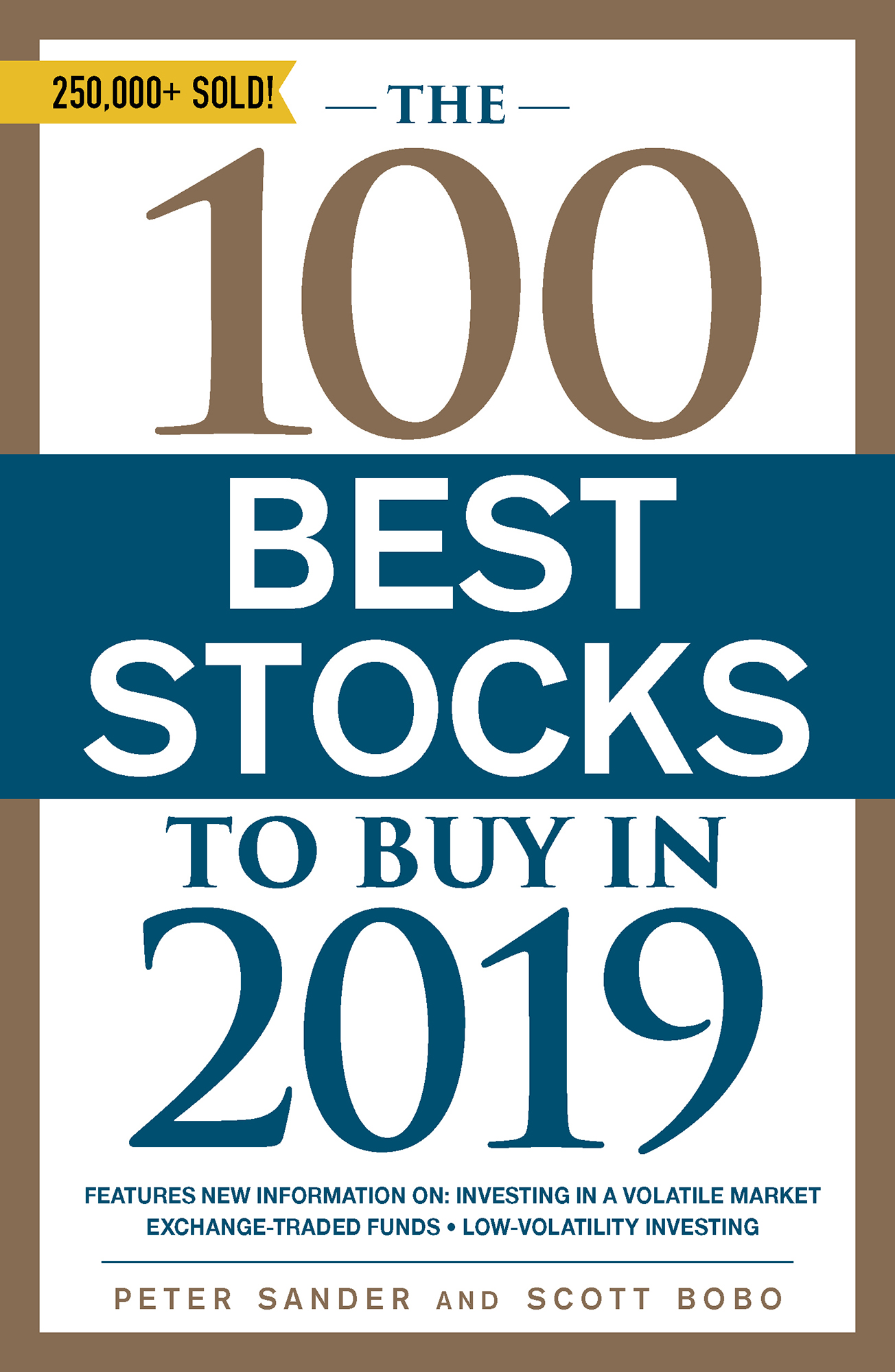
Thank you for downloading this Simon & Schuster ebook.
Get a FREE ebook when you join our mailing list. Plus, get updates on new releases, deals, recommended reads, and more from Simon & Schuster. Click below to sign up and see terms and conditions.
CLICK HERE TO SIGN UP
Already a subscriber? Provide your email again so we can register this ebook and send you more of what you like to read. You will continue to receive exclusive offers in your inbox.
We hope you enjoyed reading this Simon & Schuster ebook.
Get a FREE ebook when you join our mailing list. Plus, get updates on new releases, deals, recommended reads, and more from Simon & Schuster. Click below to sign up and see terms and conditions.
CLICK HERE TO SIGN UP
Already a subscriber? Provide your email again so we can register this ebook and send you more of what you like to read. You will continue to receive exclusive offers in your inbox.

By Peter Sander
Oh, no.
It happened again .
We lost. We lost to our old nemesisthe S&P 500 indexfor a second year in a row.
For those of you new to the 100 Best Stocks to Buy series, we measure ourselves against our closest no-brainer competitorthe S&P 500 indexwhich you could easily buy through one of many index funds and save yourself $16.99 or thereabouts plus tax on our book. Yes, you read that rightwe measure our performance. That doesnt happen that often in the investing world, and it happens even less often in the investing book world! (Can you find another investing book that actually measures the results of its picks or its proven system?)
Our 2018 picks overall came up 1.2 percent short of the S&P, which means that if you had gone to the trouble to buy the list or a substantial portion thereof, you would have gained 12.6 percent including dividendswhich would have fallen 1.2 percent short of the S&Ps 13.8 percent gain. Now that sounds pretty bad, especially since we lost last year too. Two years in a row. Is it time for us to throw in the towel? Is it time for you to switch investing books? Is it time to simply throw your money over the wall to index funds? To a financial advisor who is likely to charge you 1 percent of your portfolio value each year ?
Perish the thought!
Now youre probably anxiously awaiting a long list of excuses why this year was different, why we were on the right track until some unforeseen event like bad weather, bad debt, or bad politics knocked us unexpectedly off our saddles. Here it comes, right?
Nope, there are no excuses. But we do try to put our loss in perspective. Its a good habit to get into as an investor, and we think its a rather good habit for investment writers like us to take on as well.
* * *
Now we offer some observations on our 2018 100 Best Stocks list performance:
First, we lost by less than last year . Our 2018 100 Best list lost by 1.2 percent. In 2017 we lost by 2.2 percentso we can say we cut our loss in half! Well, the claim is valid, but in the grand scheme a loss is still a lossand the last two years of losses stand in contrast to our first seven years of wins! So, were clearly not happy stock pickers, but we do realize it could have been worse.
Second, our long-term style has gone a bit out of favor . Those of you who have consistently bought our book over the years, followed our picks, and internalized our investing strategy know that we favor stocks that among other things pay dividends (until recently, 98 percent of our picks did) and have a regular and steadily growing dividend (typically 6075 percent of our picks have raised their dividend steadily, that is, eight to ten years in a row). That philosophy has worked and has incidentally attracted us to a large number of steady-Eddie low-growth consumer staples stocks like Coke, Colgate-Palmolive, Procter & Gamble, General Mills, Campbell Soup, and the like: long-term picks bought especially for growing dividends. But rising interest rates, higher input costs, and other factors specific to these less-favored sectors caused a substantial portion of our list to underperform. Quite simply a high-yielding stock with growing dividends isnt as valuable when you can buy the same yield with a Treasury bond. Our consumer staples, REITs, and other strong payers faded this year, enough to affect the total list performance. So, for 2019, as well describe later in this narrative, we wont throw out the baby with the bathwater, but we made more changes than usual (14) and have injected some growth energy into our portfolio. This is not necessarily to say you should pick more high-flying growth stocks if youre not comfortable therewere just adding a few more to our list for you to consider.
Third, we still think we beat the S&P on a risk-adjusted basis. Risk-adjusted? Now that sounds like Wall Street jargon, but the notion of risk as it applies to our list is really important here. Why? Because while our performance missed the mark, we always strive to make our list a little safer and less volatile than the S&P 500 and the market at large. We think we did, and to make our point and in keeping with our engineering-geek ways, we decided to measure that too. Read on...
* * *
When adjusted for risk, did we maybe really win this thing?
For years weve said that our list would do better than the market (and the S&P) in a down market. But for nine consecutive years now, weve never had the chance to test that claim. We havent had a down market.
By making the claim, we maintain that most of our picks are less risky than the average stock market pick. That is, they have less downside risk , which equates roughly but not exactly to volatility . Like most others in the investment industry, we have relied on beta as a proxy for volatility. Beta measures the movement of a stock compared to the market as a whole. A beta of 1.00 means that a stock moves exactly with the market, which is a good thing when the market is going up, but a bad thing when its going down. A beta of less than 1 is bad when the market is moving up and good when it is moving down. A beta greater than 1.00 means that stock moves more than the market (more up than the market when the market is up, more down than the market when the market is down). Beta doesnt really tell you how safe a stock is because (1) it compares to the market rather than measuring the intrinsic volatility of the stock, and (2) the indicator has been calculated against an up market for the past several years.
Okay, now weve really lost you in the weeds of Wall Street speak, have we not? We apologize; that is hardly our intent. Lets circle back to the original theme here: that our picks, while underperforming the market a bit, are more stable and more sleep at night than the market as a whole. For reasons just given, our industry standard beta measure falls short of being a true measure of volatility and especially downside volatility. What to do?
We sought to find a measure that would more closely measure true volatility, that is, the up-and-down fluctuations of a price of a stock, regardless of how closely it followed the market. Once we tallied this measure for all 100 Best Stocks , we could make a definitive statement on the volatility of our portfolio as compared to the market at large.
We considered a measure or two of our own chi-square analysis but discarded them because we simply arent statisticians and dont have enough number-crunching ability to feel comfortable creating our own measure. We wanted something off the shelf, and, as so often is the case, when we need a fact or figure on a company we turned to the Value Line Investment Survey, which in this case provides a neat singular measure known as Price Stability. Bingo.
Font size:
Interval:
Bookmark:
Similar books «The 100 Best Stocks to Buy in 2019»
Look at similar books to The 100 Best Stocks to Buy in 2019. We have selected literature similar in name and meaning in the hope of providing readers with more options to find new, interesting, not yet read works.
Discussion, reviews of the book The 100 Best Stocks to Buy in 2019 and just readers' own opinions. Leave your comments, write what you think about the work, its meaning or the main characters. Specify what exactly you liked and what you didn't like, and why you think so.

